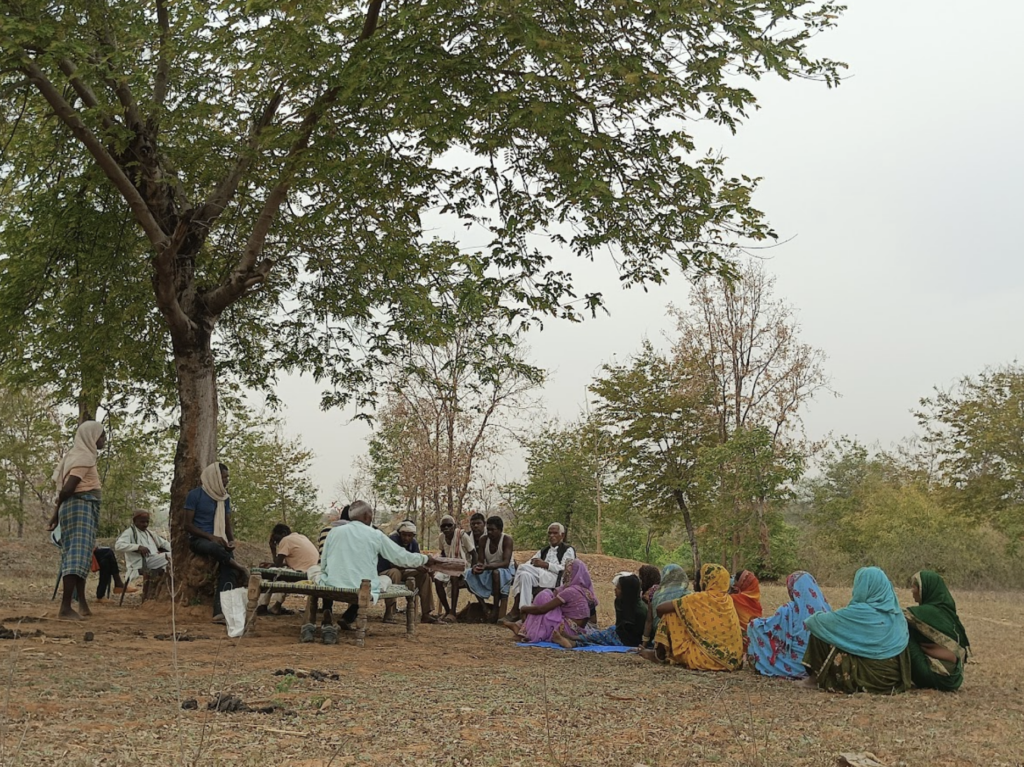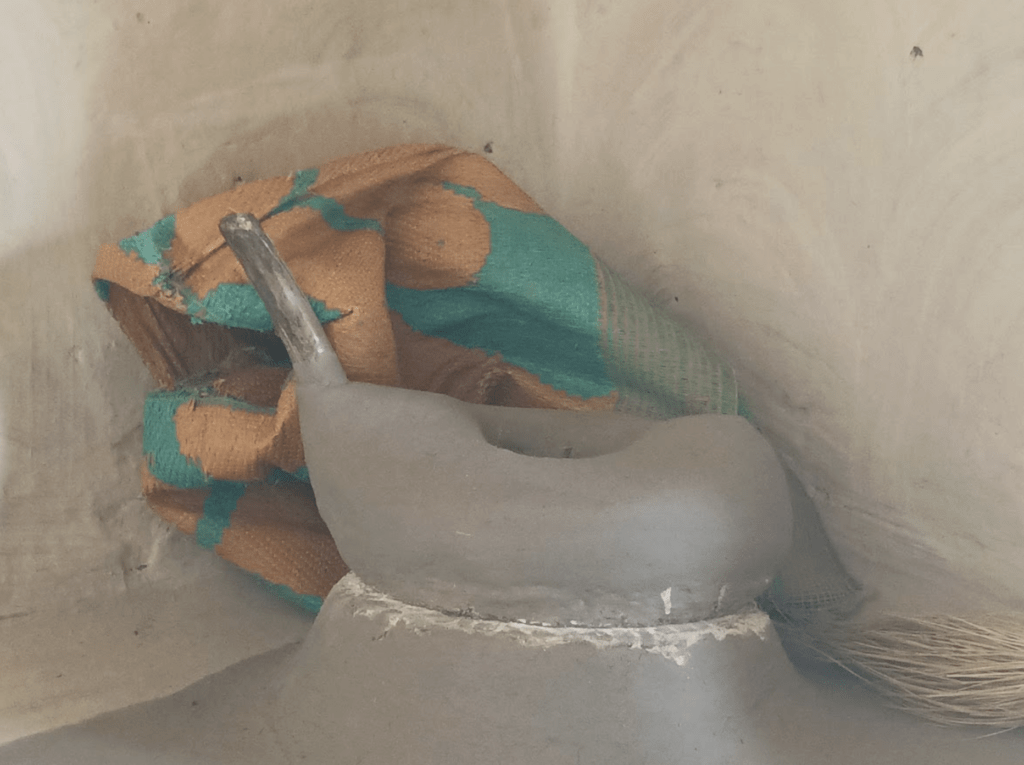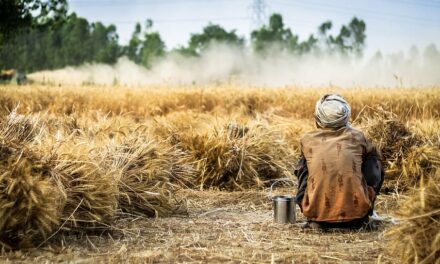28 August 2024
By Angshuman Sarma [1]
On the afternoon of March 26, 2024 a group gathered in the small hamlet of Majhauli, nestled deep within Sonbhadra district in Uttar Pradesh, India [2]. About twenty people, mostly from Majhauli tola (hamlet), were in attendance. In addition a few women had come from nearby Lilasi, and others from surrounding tolas. People gathered were called by Sokalo Gond, the President of the All India Union of Forest Working People (AIUFWP). The AIUFWP is the first national union of adivasi (indigenous) & dalit (oppressed castes) communities representing the traditional workforce in India.
This gathering was part of an ongoing effort to understand the land, livelihoods, and struggles of adivasi communities in this region. Their stories weave a narrative of resilience, tradition and the complex dynamics of shifting agricultural practices.
Majhauli, a village of roughly 600 people, sits on rugged, undulating terrain. Life here moves with the rhythm of the seasons, and agriculture remains the cornerstone of survival. For generations, the people of Birsa Nagar Tola, an extended settlement of Majhauli, cultivated millets—grains such as jowar, kodo, and sanwa—suited to the dry, rocky landscape. These crops, deeply rooted in the cultural identity of the region, are not just food but a connection to ancestral knowledge. Yet, over the last three decades, the allure of rice and wheat has gradually taken over. The promise of better market returns and the push for more “modern” crops led many farmers to abandon their traditional millets.
In conversations, elders in the community recall how the shift from millets to rice and wheat brought unintended consequences. The nutritious millets that sustained their ancestors have been replaced by high-yield varieties of commercial crops. While rice and wheat bring in more cash due to higher yields, the change has come at a cost. The community now grapples with rising health issues, which many attribute to dietary changes. The once-frequent use of medicinal plants, which grew alongside millet fields, has also dwindled, further complicating their health.
The decline in millet production isn’t just about choices; it reflects broader challenges tied to water scarcity and lost seeds. Although millets are resilient crops that require less water, the lack of reliable water sources during dry seasons has pushed farmers toward crops dependent on monsoon rains. Legal barriers also play a role. Birsa Nagar Tola remains classified as forest land, and without proper settlements, accessing groundwater requires official permissions that are hard to secure. As the community settled in Birsa Nagar over the years, many traditional millet seeds were lost, leaving only fragments of this heritage intact.
Despite these shifts, traces of traditional practices remain. A couple of farmers still cultivate small amounts of millet such as Jowar (sorghum) Kado (kodo), Sanwa (Indian barnyard) and Bajheri (pearl) that they sell to traders at modest prices. The traders, moving from village to village, collect the produce and sell it for a much higher price elsewhere. The absence of local processing facilities compounds this economic imbalance. Machines that husk rice and wheat are ill-suited for millets, whose smaller grains require specialized equipment. There are traditional millet husking instruments but they are becoming scarce and are labour intensive.
Lilasi, a neighboring village, paints a similar picture. While families there produce rice, wheat, and pulses primarily for the market, they still grow small quantities of millets for household consumption. These crops are sold directly to traders, who benefit from the added value of processing and selling in bulk. As commercial crops dominate, the dependency on market goods has increased. An average Adivasi household now spends around ₹500-600 weekly on essentials such as rice, salt, spices, and vegetables. The weekly market has become a lifeline, where people stock up on items no longer grown in their fields.
Yet, alongside this increasing market dependency, there is a collective memory of how things used to be. Elders recall intercropping practices—where multiple crops were grown together for better soil health and nutrition—although few continue these methods today. The elders still remember certain clusters of intercropping they used to do, which are as follows:
- Kodo millet, Indian barnyard millet, Pigeon Pea(Arhar), Sesame, Black gram
- Corn, Barnyard millet
- Chilli, Tomato, Onion, Sweet Potato
- Sesame, pigeon pea
- Jowar, Flax Seeds, Chickpea, Green Peas, Mustard, Coriander
The traditional agricultural calendar remains deeply embedded in the community’s rhythm, as cultivation and foraging are synchronized with the seasons. During the monsoon, the gathering of minor forest products such as mahua ( butter tree) and tendu (Indian ebony) patta ( leaves) intersects with the sowing and harvesting of crops, maintaining a delicate balance between agriculture and foraging.
The conversations during these meetings often return to the deeper issue of land rights. For many in these communities, the struggle to assert their rights over forest land represents not just a fight for survival but a resistance against larger forces threatening their way of life. The adivasi people of Sonbhadra organized under the banner of AIUFWP had led a long battle to reclaim their forest lands. The “conservation ecology” or conservation environmentalism of the Indian state aims at preserving natural habitats by isolating them from human interference. This approach is evident in the establishment of national parks and sanctuaries during the post-colonial era, with the groundwork laid during colonial times by the formation of the Forest Department.
In 2006 under the pressure of social movements, the Forest Rights Act (FRA) was enacted in India which recognises the rights of the indigenous people and forest dependent communities on their ancestral forest land. AIUFWP’s focus is on reclaiming land for adivasi, dalit and other forest dependent communities within forested areas. The union perceives the FRA as a pertinent legal tool in advancing its objectives, particularly in facilitating the recognition and protection of indigenous land rights. Majhauli is such an area where people have successfully claimed their land rights, though they are yet to get official recognition from the Forest Department. After getting land titles, the forest dwelling indigenous peoples can form a Gram Sabha, as local self governance institutions.
But the struggle does not end with gaining land rights. The question remains on what next? The process to regain control over their food systems and livelihoods is the next logical step. It is not just about producing food but about reclaiming the autonomy that was lost in the shift to market-driven agriculture. Agroecology and Food Sovereignty offer a way forward. Gram Sabhas can play an important role in that. By returning to diverse, indigenous cropping systems such as millet cultivation and integrating these with sustainable practices, these communities can resist dispossession that neoliberal corporate driven policies bring in its wake. The challenges faced by the adivasi communities of Majhauli highlight the pressing need to reclaim traditional knowledge and practices that align with their ecological landscape.
The assertion of land rights by forest-dwelling communities represents more than just a local struggle—it is a resistance against the forces of primitive accumulation. By securing control over their land, resources and food system, these communities push back against the encroachment of corporate interests and the threat of proletarianization. This fight is crucial for preserving their autonomy over production processes and ensuring their livelihoods remain intact.
What emerges from these stories is a portrait of a community at a crossroads—torn between tradition and the demands of modern agriculture, between the health benefits of millets and the economic appeal of rice and wheat. While the challenges are many, the resilience of these communities lies in their capacity to adapt while holding onto their roots. As they navigate these complexities, their struggle is a testament to the importance of land rights and agroecology in shaping livelihoods in rural India.
—
[1] Angshuman Sarma is policy officer with Focus on the Global South and is based in New Delhi, India
[2] Sonbhadra lies between Vindhya and Kaimur hills, and its topology and natural environment prompted the first Prime Minister of India Jawaharlal Nehru to refer to Sonbhadra as the ‘Switzerland’ of India











